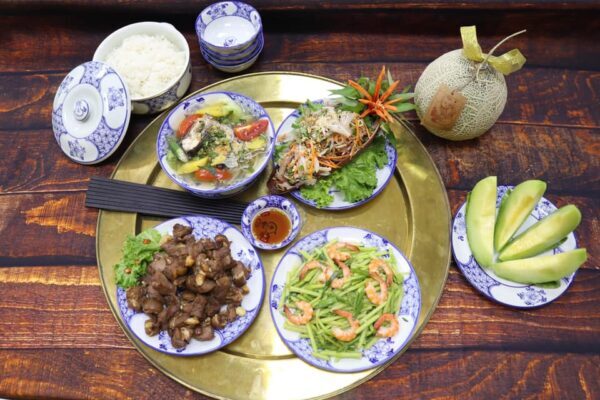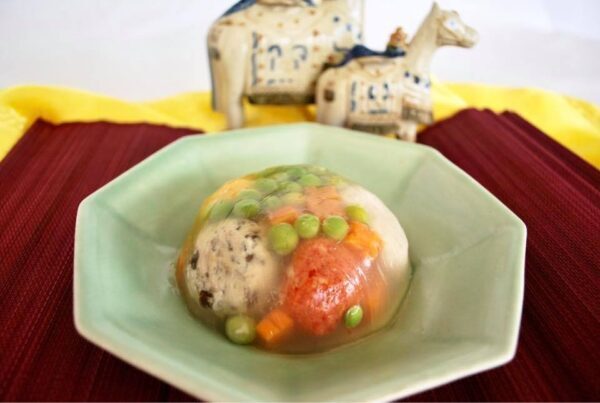Mr. Nguyen Phuong Hai was born in 1977 in a good family breeding, long-standing background in Hanoi. His grandmother is a female student at Dong Khanh School (now Trung Vuong Secondary School). When she was a young woman, she was allowed to learn housework from famous artisans of that time such as Mr. Nguyen Xien and Mrs. Van Dai, etc. In his childhood years, the boy Hai loved to follow his grandmother and his mother to the kitchen, excited when being taught how to make delicious food. Mr. Nguyen Phuong Hai inherits and nurtures his love and passion for culinary arts. Until now, chef Phuong Hai has carefully kept the “treasure” given to him by his grandmother – a book by female artist Van Dai written about Hanoi’s traditional cuisine. The book is like a guide for a young man on the way to become a professional chef.
Rediscovery of traditional dishes
Graduated from Hanoi Tourism Vocational Intermediate School, Mr. Phuong Hai stands in the kitchen at some big hotels and is a teacher at Hoa Sua Tourism Economics College. In 2003, when going to Korea to train, realizing that the traditional dishes here are very well preserved and become their own culture, Mr. Phuong Hai thought about Vietnamese traditional dishes, especially of Hanoi, which contains unique cultural values is gradually fading. Returning home, he determined to explore, collect and restore traditional cuisine.

Delicious dishes are reminiscent of old Hanoi.
Chef Nguyen Phuong Hai has encountered many difficulties in the process of restoring the inherent traditional flavors of ancient dishes because many ingredients, ancient spices have been lost and some tools used to cook before are longer produced. In order to have raw materials for the restoration of ancient dishes, he researched from books, looked up information on the Internet, went to many places to search and planted. His small garden is now full of mulberry leaves, sticky leaves, peeling…, especially fragrant leaves are very rare. Having the ingredients, he had to experiment many times to find the standard formula. Many dishes took him a year to succeed. Up to now, chef Nguyen Phuong Hai has collected and restored more than 100 traditional Hanoi dishes such as Cha Quyt, five-colored Moc Van, Nem oc nhoi, Nem ruoi, Bong ca thu…

Five-colored Moc Van – Ha Thanh ancient dish restored by talented chef Nguyen Phuong Hai.
Chef Phuong Hai shared, in his journey to rediscover old dishes, he was fortunate to have the teaching of original Hanoian artisans who are knowledgeable about traditional cuisine such as Mr. Vinh, the owner of a famous Gia Trinh bakery at No. 16 Ly Nam De, Ms. Pham Thi Vy, Rector of Hoa Sua Tourism Economics College…
In 2010, celebrating 1000 years of Thang Long – Hanoi, chef Nguyen Phuong Hai launched the book “Traditional Hanoi Food” to introduce 36 recipes of Hanoi ancient dishes. In 2013, he continued to produce a second book, teaching to cook 45 delicious dishes in Hanoi. In 2017, chef Phuong Hai with La Vong fish cakes on a culinary culture program of the world-famous television channel CNN.
Preserving the quintessence of traditional Tet meal
Spending love for Hanoi cuisine, exploring traditional dishes more deeply, Chef Phuong Hai feels the elegance, magnificence and quintessence of the old Hanoi people. That is fully expressed in the traditional Tet meals.
The traditional tray offered to grandparents, ancestors on Tet holiday of the original Hanoians is extremely sophisticated. The well-off family will present with an “eight-bowl” (8 bowls, 8 dishes). 8 bowls include: fish fin, abalone, sea cucumber, Dragon beard, fish bladder, bird, bird nest; 8 dishes have: sticky rice, fried spring rolls, boiled chicken, fried almonds, salads, roasted meat, lean pork paste or fried pie, cinnamon rolls. Middle-class families usually prepare 6 bowls, 6 dishes, or 6 bowls, 8 dishes. More popular, 3 bowls, 8 dishes. In the Tet tray there are 3 basic types of sauces: a bowl of fish sauce with chili and pepper to dab all kinds of pies, rolls; a bowl of spring roll sauce; a plate of salt with pepper, lime leaves, chili and chicken dipping. From the wartime to the time when subsidies were deprived, the tray of the Hanoians at that time was also much simpler.

Chef Phuong Hai on a traditional Tet tray.
Every year-end, chef Phuong Hai urgently prepares Tet trays according to orders from customers to enjoy at his restaurant, sometimes at the invitation of culinary experts or TV channels. The gourmets who witnessed chef Phuong Hai processing and setting up the traditional Tet trays will surely be in awe and praise when tasting them. To have a delicious Tet tray, he meticulously selects each piece of tenderloin, sausage leg, dried prawn, shiitake, bunch of vermicelli…, the spices and processing very carefully. Dried bamboo shoots are boiled, drained, scented onions, then stir-fried and hunted, seasoned to fit a little fish sauce, then put in soup and have to cook in two heat. Chicken is heated about 60 degrees to boil, let it simmer for 5 to 10 minutes, then turn off the heat for 30 minutes. When picked out, rinse through boiling water to cool the chicken skin to tighten. As for Banh chung, it is necessary to boil for 12 hours, to use a steel pot to make the cake green. When the water is exhausted, it must be added with boiled water, not cold water…
Dedicated to restoring and preserving Vietnamese delicacies, especially traditional Hanoi cuisine, chef Nguyen Phuong Hai wishes to promote and spread the cultural values and beauty of Hanoi people to domestic and international friends.
Ngan Ha
